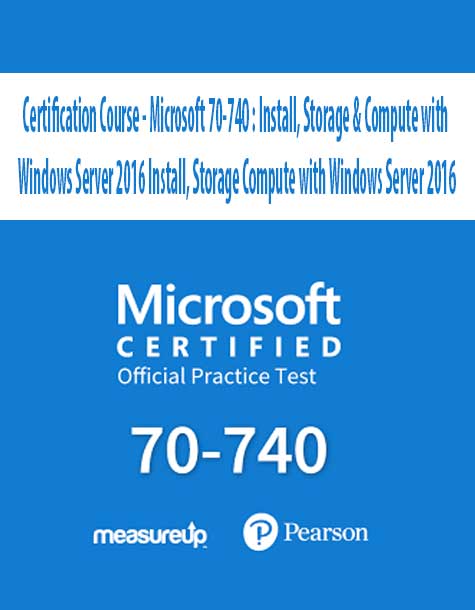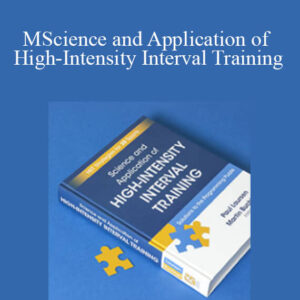[Download Now] Microsoft 70-740 : Install, Storage & Compute with Windows Server 2016
PLEASE REFER TO OUR PROOF : WATCH HERE!
Salepage: Microsoft 70-740 : Install, Storage & Compute with Windows Server 2016
Installation, Storage and Compute with Windows Server 2016 is the first step towards taking the Microsoft Certified System Administrator (MCSA) exam. This course addresses all of the concepts, terminology, and technology related to the MCSA certification and it provides the opportunity to be able to apply the knowledge to the real-world scenarios.
Installation, Storage and Compute with Windows Server 2016 course is an offering for those IT professionals who have some experience with Windows Server and want to enhance their knowledge with the latest technologies Microsoft Windows Server 2016 offers. This course gives a detailed insight in the Microsoft Hyper-V environment and how the features like high availability, fault-tolerance, disaster recovery, automated backups and network load balancing can be achieved through it. It also covers the storage aspect and the basic protocols and techniques which can be used to configure local storage systems.
Course Curriculum
Course Introduction
StartIntroduction (0:09)
StartCourse Introduction (2:31)
StartInstructor Introduction (1:24)
Chapter 01 – Installing Windows Servers in Host and Computer Environments
StartChapter 01 Introduction (2:26)
StartTopic A: Determining Windows Server 2016 Installation (0:52)
StartInstalling Windows Server 2016 (0:24)
StartIntroduction to Windows Server 2016 (2:58)
StartWindows Server Editions (5:39)
StartHardware Requirements (2:00)
StartHardware Considerations (2:08)
StartInstallation Options (1:59)
StartOptions for Managing Servers (5:06)
StartWindows Powershell (2:45)
StartWindows Powershell Basics (3:36)
StartDemo – Using Windows PowerShell (17:04)
StartWhat’s New Since 2008? (4:00)
StartWhat’s New in Windows Server 2016 (3:08)
StartTopic B: Installing Windows Server 2016 Core and Nano Editions (0:20)
StartPlanning For Installation (1:15)
StartPlanning for Nano Server (0:42)
StartUnderstanding Nano Server Roles (0:47)
StartInstalling Nano Server Roles (2:01)
StartPlanning for Server Core (3:10)
StartServer Core vs. Nano Server (3:28)
StartNano Server Installation (1:00)
StartInstallation Steps (2:49)
StartAlternative Steps to Install Nano Server (2:44)
StartDemo – Performing Nano Server Installation (11:33)
StartManaging and Configuring Nano (2:12)
StartDemo – Configuring Nano Server (19:38)
StartInstalling Server Core (3:03)
StartDemo – Installing Windows Server 2016 (8:06)
StartDemo – Configure the Local Installation (19:28)
StartUpgrades vs. Migrations (1:39)
StartChoosing In-Place Upgrades (1:32)
StartChoosing to Migrate (1:30)
StartInstallation and Migration Tools (2:19)
StartChoosing an Activation Model (2:00)
StartActivation Methods (3:27)
StartTopic C: Managing Windows Installations with Windows PowerShell (0:21)
StartPost Installation Tasks (0:42)
StartTopic D: Create, Manage, and Maintain Windows Images to Deploy (1:02)
StartCreating and Managing Deployment Images (1:20)
StartFile-Based Imaging (2:20)
StartWindows Image File Format (2:04)
StartTypes of Images (4:33)
StartImage-Based Installation Tools (4:00)
StartCreating Install Images (3:30)
StartConsiderations for Image Creation (2:58)
StartWindows ADK for Windows 10 (4:44)
StartBasic Deployment Process (1:40)
StartWindows Deployment Services (1:34)
StartWDS Components (2:05)
StartMicrosoft Deployment Toolkit 2013 (0:48)
StartChapter 01 Summary (1:35)
StartChapter 01 Review (0:10)
StartChapter 01 Quiz
Chapter 02 – Implementing Local and Enterprise Storage Solutions
StartChapter 02 Introduction (2:09)
StartTopic A: Managing Disks and Volumes in Windows Server 2016 (0:34)
StartManaging Disks and Volumes (0:30)
StartPartition Table Formats (2:45)
StartDisk Types (2:18)
StartRequired Disk Volumes (1:24)
StartFile Systems (4:38)
StartResilient File System (3:02)
StartDemo – Working with File Systems (10:34)
StartVirtual Hard Disks (2:10)
StartManaging Virtual Hard Disks (0:46)
StartSelecting Physical Disk Types (4:01)
StartWorking with Disk Volumes (3:50)
StartVolume Management Tools (2:37)
StartDemo – Managing Volumes (7:43)
StartUnderstanding RAID (4:21)
StartHardware vs. Software RAID (2:21)
StartRAID Types (4:12)
StartTopic B: Implementing and Managing Storage Spaces (0:38)
StartImplementing and Managing Storage Spaces (2:37)
StartRequirements for Storage Spaces (2:27)
StartStorage Space Features (6:47)
StartDemo – Configuring Storage Spaces (7:22)
StartChanges to Storage Spaces (3:44)
StartStorage Space Usage Scenarios (1:56)
StartStorage Spaces Direct Deployment Scenarios (3:50)
StartManaging Storage Spaces (1:47)
StartUsing Windows PowerShell with Storage Spaces (1:54)
StartManaging Disk Failure with Storage Spaces (8:05)
StartMonitoring Storage Spaces (3:51)
StartTopic C: Configuring Data Deduplication (0:33)
StartOverview of Data Deduplication (3:45)
StartEnhancements in Windows Server 2016 (1:48)
StartData Deduplication Requirements (1:56)
StartData Deduplication Components (2:42)
StartData Deduplication Process (2:35)
StartPlanning Data Deduplication (4:13)
StartData Deduplication Usage Scenarios (2:18)
StartDemo – Installing and Configuring Data Deduplication (14:20)
StartMonitoring and Maintaining Data Deduplication (4:24)
StartTopic D: Understanding Various Types of Storage (0:38)
StartOverview of Storage Solutions (1:13)
StartDirect Attached Storage (2:04)
StartNetwork Attached Storage (2:31)
StartStorage Area Networks (2:36)
StartComparing Storage Solutions (4:06)
StartComparing Storage Technology (1:55)
StartTopic E: Fibre Channel, iSCSI, and Fibre Channel over Ethernet (0:44)
StartFibre Channel (2:11)
StartFibre Channel Layouts (1:08)
StartFibre Channel Considerations (4:03)
StartiSCSI (3:31)
StartiSCSI Target Server (2:29)
StartiSCSI Initiator (0:32)
StartConsiderations for Implementing iSCSI (2:44)
StartTopic F: Understanding iSNS, DCB, and MPIO (0:35)
StartiSNS (2:24)
StartiSNS Functions and Installation (1:38)
StartData Center Bridging (2:28)
StartMPIO (2:09)
StartTopic G: Configuring File and Folder Sharing in Windows Server 2016 (0:44)
StartConfiguring Sharing in Windows Server 2016 (1:05)
StartServer Message Block (2:18)
StartConfiguring SMB Shares (3:03)
StartDemo – Configuring SMB Shares (9:08)
StartNetwork File System (2:25)
StartConfiguring NFS Shares (1:53)
StartChapter 02 Summary (3:19)
StartChapter 02 Review (0:10)
StartChapter 02 Quiz
Chapter 03 – Implementing Hyper-V Virtualization
StartChapter 03 Introduction (1:28)
StartTopic A: Installing Hyper-V Virtualization (0:13)
StartIntroducing Hyper-V (2:14)
StartNew Host Features in Windows Server 2016 (3:36)
StartNew VM Features in Windows Server 2016 (2:55)
StartIntroducing Windows Server Containers (2:55)
StartHyper-V Prerequisites (3:00)
StartNested Virtualization (1:51)
StartDemo – Installing the Hyper-V Role (9:03)
StartTopic B: Configuring Storage and Networking on Hyper-V Hosts (0:30)
StartUsing Virtual Hard Disks in Hyper-V (1:39)
StartVirtual Hard Formats (1:57)
StartVirtual Hard Disk Types (3:12)
StartConsiderations for Virtual Hard Disks (1:57)
StartFibre Channel in Hyper-V (1:07)
StartChoosing Storage for Virtual Machines (2:36)
StartDemo – Managing Storage in Hyper-V (8:39)
StartHyper-V Networks (2:25)
StartDemo – Creating a Virtual Switch (6:22)
StartConsiderations for Hyper-V Networks (2:58)
StartNew Features in Windows Server 2016 (4:14)
StartTopic C: Configuring and Managing Virtual Machines (0:18)
StartOverview of Virtual Machines (0:50)
StartConfiguration Versions (1:18)
StartGeneration Versions (1:30)
StartDemo – Creating Virtual Machines (10:11)
StartVirtual Machine Settings (3:12)
StartNew Options in Windows Server 2016 (3:06)
StartShielded Virtual Machines (1:23)
StartBest Practices for Virtual Machines (1:50)
StartOverview of Virtual Machine Management (0:59)
StartManaging Virtual Machine States (1:53)
StartWorking with Checkpoints (3:10)
StartImporting and Exporting VMs (3:04)
StartWindows PowerShell Direct (1:30)
StartChapter 03 Summary (1:32)
StartChapter 03 Review (0:10)
StartChapter 03 Quiz
Chapter 04 – Implementing Windows Containers
StartChapter 04 Introduction (1:13)
StartTopic A: Understanding Windows Server and Hyper-V Containers (0:39)
StartOverview of Windows Server Containers (0:39)
StartConcepts and Definitions (2:42)
StartWindows Server Containers (2:03)
StartOverview of Hyper-V Containers (1:26)
StartBenefits of Hyper-V Containers (1:32)
StartUsage Scenarios (3:44)
StartInstallation Requirements (1:51)
StartTopic B: Deploying Windows Server and Hyper-V Containers (0:45)
StartDeploying Windows Server Containers (1:51)
StartDeploying Hyper-V Containers (1:30)
StartManaging Containers (0:56)
StartDemo – Installing the Containers Feature (2:31)
StartTopic C: Using Docker to Install, Configure, and Manage Containers (0:13)
StartOverview of Docker (1:22)
StartSupport for Docker in Windows (1:20)
StartDocker Terminology (0:56)
StartDocker Toolbox (1:55)
StartDocker Solutions (1:19)
StartManagement of Docker (1:17)
StartOverview of Docker Hub (2:04)
StartDocker with Microsoft Azure (1:31)
StartChapter 04 Summary (0:59)
StartChapter 04 Review (0:10)
StartChapter 04 Quiz
Chapter 05 – Implementing High Availability
StartChapter 05 Introduction (3:53)
StartTopic A: Overview of High Availability and Disaster Recovery (1:14)
StartUnderstanding High Availability (6:12)
StartContinuous Availability (2:13)
StartBusiness Continuity (2:10)
StartBusiness Continuity Strategies (0:34)
StartDeveloping Disaster Recovery Plans (3:13)
StartService Level Agreements (3:59)
StartHighly Available Networking (2:10)
StartHighly Available Storage (2:14)
StartHigh Availability for Virtual Machines (5:38)
StartUnderstanding Live Migration (1:17)
StartLive Migration Process (3:44)
StartHyper-V Replica (2:14)
StartPlanning for Hyper-V Replica (1:33)
StartImplementing Hyper-V Replica (1:37)
StartOverview of Windows Backup (1:53)
StartDemo – Installing and Configuring Windows Server Backup (5:25)
StartOverview of Failover Clustering (2:40)
StartHigh Availability through Failover Clustering (0:41)
StartFailover Clustering Terminology (1:57)
StartClustering Types and Categories (2:12)
StartTopic B: Implementing Network Load Balancing (0:47)
StartUnderstanding NLB (1:51)
StartNLB Operation (1:50)
StartNLB Features in Windows Server 2016 (1:22)
StartNLB Deployment Requirements (2:21)
StartDemo – Deploying NLB (6:04)
StartNLB Configuration Options (2:50)
StartNLB Host Parameters (1:25)
StartNetwork Considerations for NLB (1:45)
StartPlanning NLB Implementation (4:15)
StartTopic C: Planning and Configuring Failover Clustering (0:26)
StartThe Importance of Planning (1:06)
StartApplication Considerations (1:47)
StartStorage Considerations (0:57)
StartStorage Requirements (0:48)
StartHardware Requirements (2:04)
StartNetwork Requirements (1:35)
StartDemo – Verifying NIC Capabilities (4:19)
StartAdditional Planning Considerations (3:31)
StartIntroducing Quorum (2:57)
StartDynamic Quorum (2:26)
StartTesting the Configuration (1:07)
StartCreation Process (1:40)
StartDemo – Creating a Failover Cluster (27:59)
StartCluster Roles (1:26)
StartCommon Cluster Management Tasks (2:00)
StartCluster Properties (1:11)
StartFailover and Failback Configuration (2:25)
StartStorage Configuration (1:16)
StartNetwork Configuration (2:41)
StartConfiguring Quorum Options (1:52)
StartDemo -Configuring the Quorum (3:17)
StartTopic D: Maintaining a Failover Cluster (0:39)
StartOverview of Maintaining Failover Clusters (0:51)
StartMonitoring Failover Clusters (3:20)
StartBackup and Restore (2:30)
StartTroubleshooting Failover Clusters (2:34)
StartManaging Cluster Communication (2:30)
StartCluster Aware Updating (CAU) (2:22)
StartTopic E: Troubleshooting Failover Clustering (0:27)
StartTroubleshooting Communication (2:50)
StartTroubleshooting Cluster Name Objects (1:49)
StartQuorum Issues (2:23)
StartUsing Event Viewer (2:29)
StartUsing Windows PowerShell (1:26)
StartTopic F: Integrating Failover Clustering and Hyper-V (0:15)
StartHigh Availability Options (2:36)
StartHost Clustering Overview (3:27)
StartFailover Clustering for Hyper-V in Windows Server 2016 (1:42)
StartHyper-V Cluster Components (2:18)
StartHyper-V Failover Cluster Prerequisites (2:33)
StartImplementation Process (2:12)
StartCluster Shared Volumes (2:35)
StartConfiguring a Shared Virtual Hard Disk (1:27)
StartScale Out File Server (SOFS) (2:46)
StartSOFS Requirements (0:42)
StartTopic G: Configuring Site Availability (0:46)
StartStretch Clustering (1:49)
StartPrerequisites for Stretch Clustering (2:49)
StartTypes of Replication (3:17)
StartOverview of Storage Replica (1:10)
StartQuorum Modes for Stretch Clusters (1:36)
StartChapter 05 Summary (1:48)
StartChapter 05 Review (0:10)
StartChapter 05 Quiz
Chapter 06 – Maintaining and Monitoring Server Environments
StartChapter 06 Introduction (2:44)
StartTopic A: Windows Server Update Services (1:17)
StartOverview of WSUS (3:03)
StartDeployment Options (6:04)
StartServer Requirements (1:31)
StartConfiguring Clients (2:39)
StartAdministering WSUS (1:38)
StartApproving Updates (1:44)
StartDemo – Installing and Configuring WSUS (15:20)
StartTopic B: Windows PowerShell Desired State Configuration (DSC) (0:36)
StartOverview of PowerShell DSC (2:52)
StartRequirements for PowerShell DSC (3:31)
StartImplementing PowerShell DSC (3:20)
StartTopic C: Windows Server 2016 Monitoring Tools (0:54)
StartOverview of Monitoring Tools (1:53)
StartUsing Task Manager (2:28)
StartDemo – Using Task Manager (4:45)
StartPerformance Monitor (2:48)
StartDemo – Using Performance Monitor (9:30)
StartMonitoring Resources and Reliability (2:33)
StartEvent Viewer (3:39)
StartDemo – Using Event Viewer (12:37)
StartMonitoring with Server Manager (2:16)
StartChapter 06 Summary (1:12)
StartCourse Review (0:09)
StartChapter 06 Quiz
StartCourse Closure (1:59)
Delivery Method
– After your purchase, you’ll see a View your orders link which goes to the Downloads page. Here, you can download all the files associated with your order.
– Downloads are available once your payment is confirmed, we’ll also send you a download notification email separate from any transaction notification emails you receive from coursesblock.com.
– Since it is a digital copy, our suggestion is to download and save it to your hard drive. In case the link is broken for any reason, please contact us and we will resend the new download link.
– If you cannot find the download link, please don’t worry about that. We will update and notify you as soon as possible at 8:00 AM – 8:00 PM (UTC 8).
Thank You For Shopping With Us!







